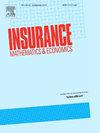保险公司最优分红与风险控制问题
IF 2.2
2区 经济学
Q2 ECONOMICS
引用次数: 0
摘要
本文研究了在股东支付时间受泊松过程到达时间约束的保险公司的最优风险政策和股利策略问题。同时,通过比例再保险持续管理风险控制。我们的分析证实了在所有可接受的周期性经典策略中,在第一次破产之前最大化预期净现值的周期性经典障碍策略的最优性。本文章由计算机程序翻译,如有差异,请以英文原文为准。
An optimal periodic dividend and risk control problem for an insurance company
We study the problem of optimal risk policies and dividend strategies for an insurance company operating under the constraint that the timing of shareholder payouts is governed by the arrival times of a Poisson process. Concurrently, risk control is continuously managed through proportional reinsurance. Our analysis confirms the optimality of a periodic-classical barrier strategy for maximizing the expected net present value until the first instance of bankruptcy across all admissible periodic-classical strategies.
求助全文
通过发布文献求助,成功后即可免费获取论文全文。
去求助
来源期刊

Insurance Mathematics & Economics
管理科学-数学跨学科应用
CiteScore
3.40
自引率
15.80%
发文量
90
审稿时长
17.3 weeks
期刊介绍:
Insurance: Mathematics and Economics publishes leading research spanning all fields of actuarial science research. It appears six times per year and is the largest journal in actuarial science research around the world.
Insurance: Mathematics and Economics is an international academic journal that aims to strengthen the communication between individuals and groups who develop and apply research results in actuarial science. The journal feels a particular obligation to facilitate closer cooperation between those who conduct research in insurance mathematics and quantitative insurance economics, and practicing actuaries who are interested in the implementation of the results. To this purpose, Insurance: Mathematics and Economics publishes high-quality articles of broad international interest, concerned with either the theory of insurance mathematics and quantitative insurance economics or the inventive application of it, including empirical or experimental results. Articles that combine several of these aspects are particularly considered.
 求助内容:
求助内容: 应助结果提醒方式:
应助结果提醒方式:


